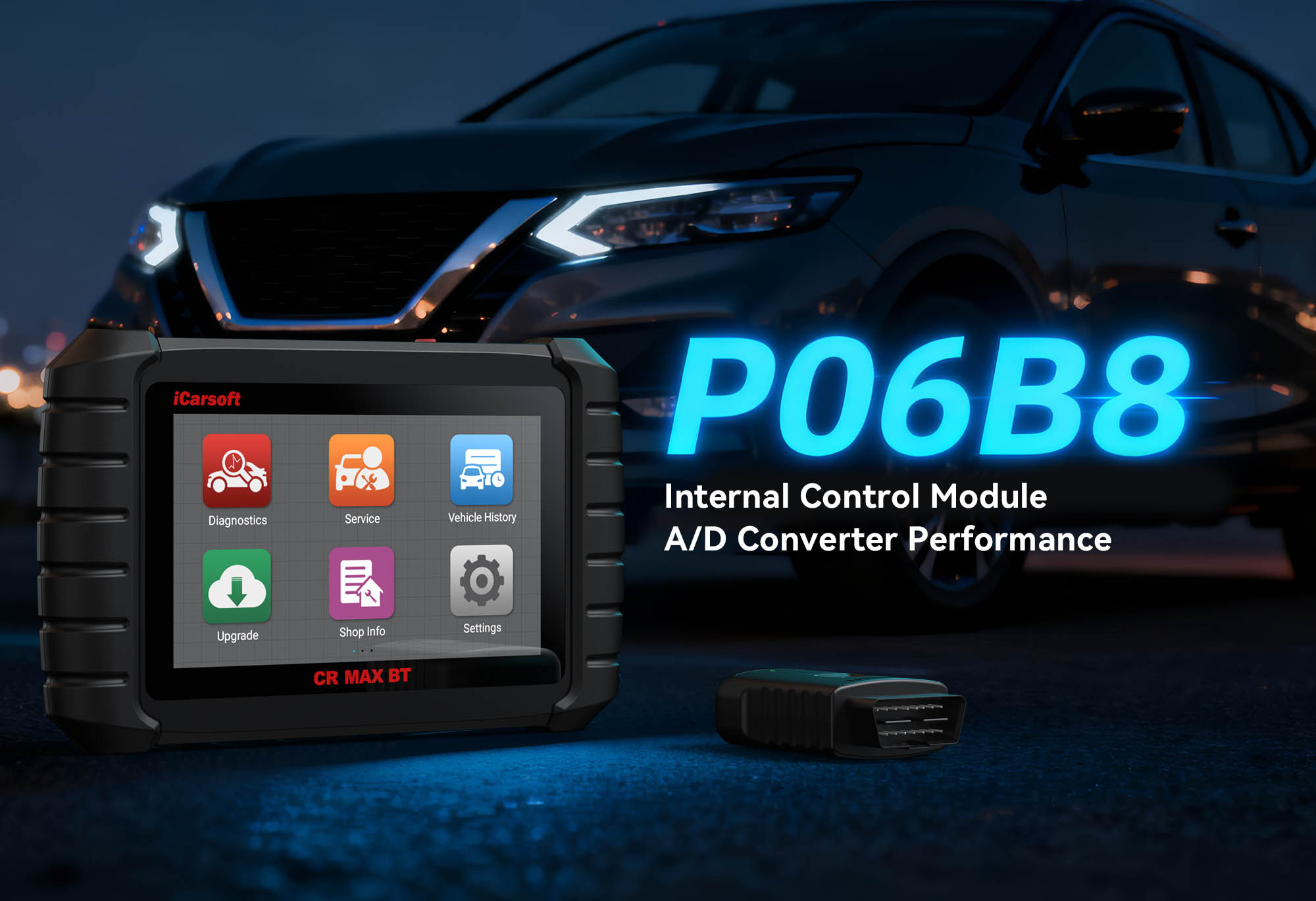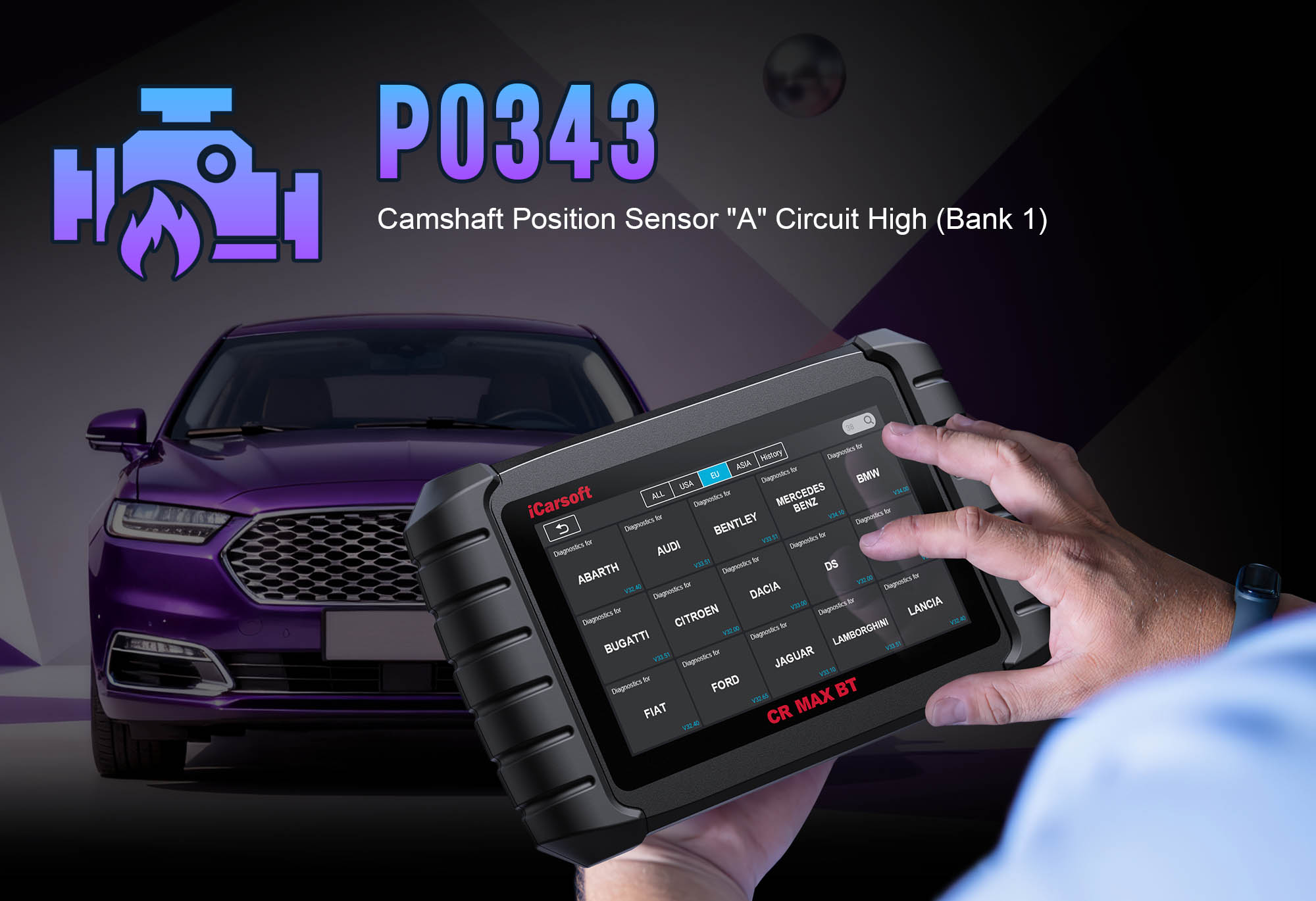Diagnose & Clear P050D with iCarsoft CR Pro S: Fix Idle Air Control System Performance/Stuck Closed
If your check engine light illuminates and you notice symptoms like high idle speed (e.g., 1,500+ RPM at stoplights), rough idling, or difficulty starting, a diagnostic scan will likely return P050D. This OBD-II code stands for "Idle Air Control (IAC) System Performance" or "Idle Air Control System Stuck Closed," indicating the Engine Control Module (ECM) has detected that the idle air control system isn’t maintaining the target idle speed—often because the idle air control valve (IACV) is stuck in a closed position, restricting airflow to the engine at idle.
The idle air control system is critical for stable engine idle: when the throttle body is closed (e.g., at stoplights), the IACV regulates the amount of air bypassing the throttle plate to the intake manifold. The ECM adjusts the IACV’s opening based on engine load, temperature, and electrical demands (e.g., AC on, headlights on) to keep idle speed consistent (typically 600–900 RPM for gasoline engines). A "performance" or "stuck closed" fault (P050D) means the IACV can’t open enough to allow sufficient airflow—causing the engine to idle too low (risk of stalling) or forcing the ECM to compensate with extra fuel, wasting gas and increasing emissions.
Basic scanners may only flag "IAC system fault" but can’t test valve functionality, measure bypass airflow, or calibrate the idle speed. The iCarsoft CR Pro S, with its idle system diagnostics, live IACV tracking, and throttle body calibration tools, solves this. Let’s walk through how to diagnose and resolve P050D with precision.
Understanding P050D: Causes & Key Symptoms
A faulty idle air control system disrupts airflow at idle, leading to symptoms tied to unstable or incorrect idle speed—these clues help separate valve/circuit issues from other engine faults.
Key Symptoms of P050D
-
High Idle Speed: The engine idles at 1,200+ RPM (instead of 600–900 RPM) as the ECM overcompensates for restricted airflow.
-
Rough Idling: The engine shakes or vibrates at idle, with speed fluctuating by 100+ RPM (e.g., 700 RPM to 900 RPM and back).
-
Difficulty Starting: The engine cranks longer than usual or stalls immediately after starting—insufficient idle airflow prevents smooth combustion.
-
Stalling at Idle: The engine shuts off when stopped (e.g., at stop signs) because the IACV is stuck closed, cutting off bypass air.
-
Poor Fuel Efficiency: The ECM enriches the fuel mixture to balance low airflow, increasing fuel consumption by 10–15%.
-
Check Engine Light: Triggers when the ECM detects idle speed mismatch for 2+ drive cycles (may be intermittent).
Common Causes of P050D
|
Cause
|
Description
|
|
Clogged Idle Air Control Valve (IACV)
|
Carbon deposits from oil blow-by or low-quality fuel block the valve’s passageways, preventing full opening.
|
|
Stuck Closed IACV
|
The valve’s internal solenoid or plunger seizes (common in valves >80,000 miles—heat/wear damages moving parts).
|
|
Dirty Throttle Body
|
Carbon buildup on the throttle plate restricts airflow, forcing the IACV to overwork and eventually stick.
|
|
Faulty IACV Wiring/Connector
|
Corroded terminals, frayed wires, or loose connections disrupt ECM signals to the valve.
|
|
Vacuum Leaks
|
Leaks in the intake manifold or hoses allow unmeasured air, confusing the ECM and causing idle instability.
|
|
ECM Software Glitch
|
Outdated firmware or calibration errors prevent the ECM from sending correct IACV control signals.
|
Why iCarsoft CR Pro S Excels at Diagnosing P050D
The CR Pro S outperforms basic tools with features tailored to idle air control system diagnostics—critical for resolving P050D without guesswork:
Live IACV Monitoring
Tracks real-time IACV position (e.g., 20% open) and control signals to spot stuck valves.
Idle Speed Comparison
Displays target vs. actual idle speed to highlight mismatches triggering P050D.
IACV Activation Tests
Manually opens/closes the IACV to test functionality—confirms if the valve is stuck.
Throttle Body Calibration
Resets and calibrates the throttle body after cleaning/replacement for proper idle airflow.
Vacuum Leak Detection
Measures intake manifold pressure to identify leaks that worsen idle system performance.
Global Vehicle Coverage
Works with 500+ models (gasoline/hybrid) from Ford, Toyota, BMW—adapts to IACV designs (stepper motor/solenoid).
Step-by-Step: Diagnose P050D with iCarsoft CR Pro S
-
1. Verify Idle Speed & Symptom Consistency
Start with visual checks:
1. Idle Speed Check: Warm engine to operating temp—normal idle = 600–900 RPM; P050D may show >1,200 RPM.
2. Electrical Load Test: Turn on AC/headlights—idle should increase 50–100 RPM. No change = IAC system failure.
-
2. Connect the CR Pro S & Confirm the Code
1. Plug into OBD-II port (use adaptors for older models).
2. Power on and select vehicle via Auto VIN Identify.
3. Navigate to Engine > Fault Codes to confirm P050D. Tap Code Details for vehicle tips (e.g., "Toyota Corolla: Check IACV position target 30%, actual 5%").
-
3. Locate the Idle Air Control Valve (IACV)
Use the tool’s mapping:
1. Navigate to Component Location > Engine > Air Intake > Idle Air Control Valve.
2. Note:
- Position: Mounted on throttle body or air intake tube—cylindrical/rectangular with electrical pins.
- Wiring: 2–4 wires connecting to ECM.
- Throttle Body: IACV often shares mounting bracket with throttle body.
-
4. Visual Inspection of the IACV & Throttle Body
Check for obvious issues:
1. IACV Connector: Disconnect—check for corrosion/bent pins (clean with contact cleaner).
2. IACV Ports: Inspect vacuum ports for carbon buildup (blockage indicates clogging).
3. Throttle Body: Remove air intake tube—check throttle plate for carbon buildup (restricts airflow).
4. Vacuum Hoses: Examine for cracks/leaks—test with soapy water (bubbles = leaks).
-
5. Analyze Live Idle System Data
Real-time data confirms system health:
1. Start engine, warm to temp.
2. Navigate to Engine > Live Data > Air Intake > Idle Air Control System and monitor:
- IACV Position: Normal = 10–50% open; P050D = <5% open (stuck closed).
- Idle Speed: Target vs. actual—difference >200 RPM confirms P050D.
- Intake Pressure: Normal = 35–50 kPa; <30 kPa = vacuum leak; >55 kPa = restricted airflow.
-
6. Test the IACV Functionality (Bi-Directional Activation)
Manually control the IACV:
1. Ensure engine off, reconnect IACV connector.
2. Navigate to Special Functions > Engine > IACV Activation Test.
3. Adjust IACV position (10%, 50%, 90% open):
- Listen for Movement: Clicking/whirring (stepper motor) or hissing (solenoid) indicates valve operation.
- Idle Speed Response: Start engine—idle should increase as valve opens. No response = stuck/faulty IACV.
4. Test resistance (disconnect IACV): Normal = 10–30 ohms (solenoid), 50–100 ohms (stepper motor). Out-of-range = replace valve.
-
7. Clean the IACV & Throttle Body
Remove carbon buildup:
1. Safety First: Disconnect battery, remove IACV from throttle body (follow Torque Guide).
2. IACV Cleaning: Spray throttle body cleaner into ports, brush deposits—avoid scratching internal parts.
3. Throttle Body Cleaning: Wipe throttle plate and bore with cleaner—open plate to clean both sides.
4. Reinstall: Let parts dry, reassemble, reconnect battery.
-
8. Test for Vacuum Leaks
Identify problematic leaks:
1. Navigate to Special Functions > Intake Manifold Pressure Test.
2. Idle engine—observe pressure (35–50 kPa normal).
3. Spray cleaner on suspect areas (gaskets/hoses):
- Pressure increase = leak (replace gaskets/hoses, torque manifold bolts to 15–20 Nm).
-
9. Calibrate the Throttle Body & IAC System
Reset ECM learning:
1. Navigate to Special Functions > Throttle Body Calibration.
2. Follow prompts (idle relearn or drive cycle):
- ECM learns new IACV position and throttle plate alignment.
3. Verify live data: IACV position 10–50%, idle speed target/actual match (±50 RPM).
-
10. Repair & Clear P050D
Fix based on diagnostics:
1. Address issues:
- Clogged IACV/Throttle Body: Clean as in step 7.
- Stuck IACV: Replace with OEM valve (use Part Lookup).
- Vacuum Leaks: Replace hoses/gaskets.
- ECM Glitch: Update firmware via Update Manager.
2. Clear code: Engine > Fault Codes > Clear Codes.
-
11. Validate the Repair
Confirm system functionality:
1. Idle speed stabilizes at 600–900 RPM when warm.
2. Electrical loads increase idle by 50–100 RPM (stays stable).
3. Test drive 30–40 minutes—no stalling/rough idling.
4. Post-drive scan: Use Idle System Scan after 100 miles.
Preventing P050D Recurrence
Use the iCarsoft CR Pro S to maintain idle air control system health:
-
Regular Cleaning: Clean IACV and throttle body every 30,000–40,000 miles (set Service Reminder).
-
Fuel Quality: Use top-tier gasoline with detergents to reduce carbon deposits.
-
Vacuum System Checks: Inspect hoses/manifold gaskets annually—fix leaks early.
-
ECM Updates: Check for firmware updates via Update Manager every 6 months.
Conclusion
P050D’s idle air control system fault causes unstable idle and wasted fuel—but the iCarsoft CR Pro S simplifies diagnosis with IACV testing, airflow monitoring, and calibration tools. Whether cleaning a clogged valve, fixing leaks, or updating the ECM, this tool ensures you fix the root cause (not just the symptom).
With the CR Pro S, you’ll restore smooth, consistent idle speed, eliminate stalling and high idle, and improve fuel efficiency—no more costly guesswork or unnecessary IACV replacements.
FAQs About P050D Code
Q: Can I drive with P050D?
A: Yes, but with caution—high idle or stalling risks exist. Fix P050D promptly to avoid fuel waste and potential engine damage from rich fuel mixtures.
Q: How much does it cost to fix P050D?
A: $50–$150 for cleaning IACV/throttle body; $100–$300 for replacing IACV; $80–$200 for vacuum hose/gasket repairs. The CR Pro S saves by avoiding unnecessary part replacements.
Q: Why does P050D return after cleaning the IACV?
A: Likely causes: unresolved vacuum leaks, dirty throttle body, or ECM calibration issues. Use the CR Pro S to retest the system and perform throttle body calibration.
Q: What’s the difference between P050D and P0505?
A: P050D = "Idle Air Control System Performance/Stuck Closed" (restricted airflow); P0505 = "Idle Control System Malfunction" (broad idle issue, may include airflow or electrical faults). The CR Pro S differentiates via live IACV data.





